Top 10 Patterns from Lake Seminole
Sweet spots carried the majority of the top pros
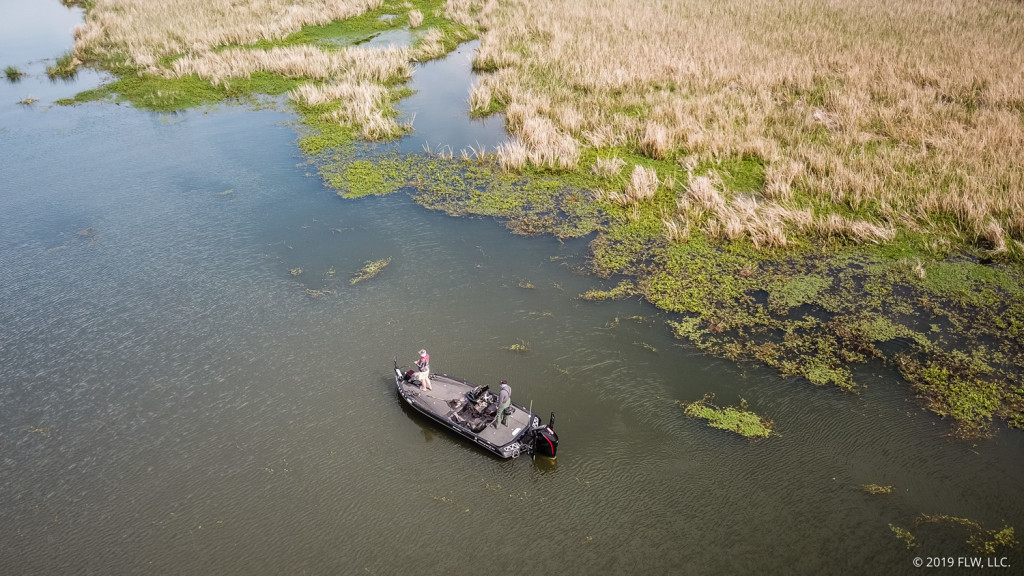
Prespawn bass were the main storyline for the third stop of the FLW Tour on Lake Seminole presented by Costa. Finding areas that held concentrations of staging bass was vital to fishing all four days and most of the pros rode individual spots to their respective finishes.
Brian Latimer called a several hundred yard flat along the Flint River home and flipped grass clumps for just a handful of bites throughout the day for his win. However, most of the top 10 kept a vibrating jig in their hands and camped on one spot to take advantage of a fast and furious morning bite.
Here’s a look at how the rest of the top 10 pros got it done on Seminole.
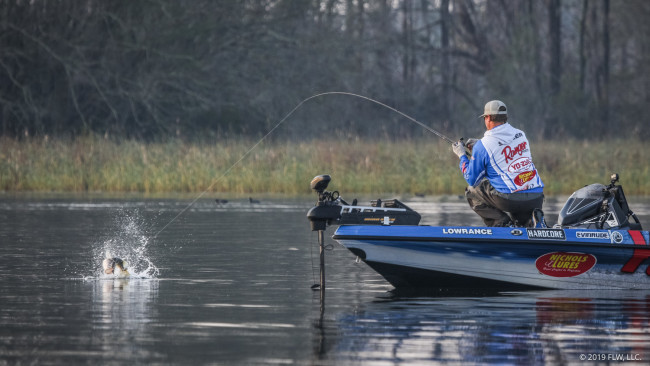
2. Setzer drags a ditch
Braxton Setzer gave Latimer a run a for his money and led after day one thanks to his 25-pound, 15-ounce limit. If it wasn’t for weighing just two fish for 7-11 on day two, he probably would have taken home his first Tour title.
“I got four bites on day two and landed two of them,” Setzer says. “I think the boat pressure in the area got to them. That’s the only reason I could think as to why they didn’t bite that good.”
Still, those two bass were enough to send him fishing into the weekend where he’d run right back to the same waypoint Saturday morning and sack up 24-8 in a hurry. On the final day, it produced another 20-12 to give him his best finish on Tour thus far.
Setzer’s spot was located in a ditch leading to a spawning flat in Spring Creek near Big Jim’s. The ditch had a bare spot in it, which is where the majority of his fish came from. When the spot was on, it was on. Almost all of his tournament weight came within the first two hours of fishing.
“I actually found it just putting around and looking at my Lowrance. I saw that there was a ditch and it looked good, so I turned around to fish it and got a bite,” explains the Montgomery, Ala., pro. “I worked up the ditch and got some better fish over by where [Joseph] Webster was fishing. He pulled in there first on day one, so I fished the bare spot. It all worked out in the end.”
Setzer rotated through a few baits, but a Zoom Ultra Vibe Speed Worm on a 1/4-ounce weight with 16-pound-test Yo-Zuri Top Knot fluorocarbon got the most work done. He threw the worm on a 7-7, heavy Phenix Feather rod.

3. Collings camped by the dam
In his second year on Tour, Sheldon Collings of Grove, Okla., fished a solid event en route to his first top 10 finish on Tour.
Like Setzer, Collings did most of his damage right away in the morning and got the ball rolling on day one with 23-14. While he was one of a handful of anglers who caught limits every day of the event, he wouldn’t crack the 20-pound mark again until the final day. Still, he locked in on one spot and played the event like a seasoned veteran.
Collings’ area was essentially a high spot on a flat near the dam with a mix of grass mixed around it.
“I found that spot last year in the Costa [FLW Series] event,” Collings says. “I idled over it and saw there were fish there in practice this week and knew I could catch some. The grass is thick on top in about 6 feet, but sparse out deeper in about 10 feet.
"It’s really not the best looking grass, but the fish were staging there to spawn and I don’t really know why.”
Collings caught the bulk of his fish on a ½-ounce homemade vibrating jig with a Z-Man Razor ShadZ trailer. To keep ‘em pinned, he tied it to 17-pound-test fluorocarbon and used a Tailwalk Fullrange series rod. He notes the key was not reeling the bait steadily, but rather pumping and dragging the bait along.
“[Sunday] I had to drag the bait slow enough to barely feel the blade moving,” he adds.

4. Bolton works sandbar for another top 10
Terry Bolton has been on fire all season long and currently leads the Angler of the Year race after not missing a top-30 cut yet.
Bolton was fairly consistent over the first three days of fishing with bags of 14-4, 14-13 and 16-3, respectively. But, he saved the best for last when he catapulted to fourth with 27-2 – the biggest limit of the event
“There’s a window before fish spawn when they are real aggressive and [Sunday] I hit it,” Bolton says. “They were new fish and they came to the hill.”
The Benton, Ky., pro worked a large area at the mouth of Spring Creek, targeting sand spots and the grass clumps and edges that surrounded them.
“I used my Costas to see the grass edges and sand spots and I would throw around there,” Bolton continues. “I had to find a new area each day.”
Fishing painfully slow, Bolton tossed a Neko-rigged Zoom Fluke Stick with the tail pinched off. His terminal tackle included a 1/0 or 2/0 VMC Weedless Neko hook with part of a 1/16-ounce VMC Neko Weight shoved in the end. To get the fish to the boat, Bolton used 10-pound-test Sufix Performance braid tied to an 8-pound-test Sufix fluorocarbon leader and a 6-11, medium Lew’s Custom Speed Stick Lite rod.
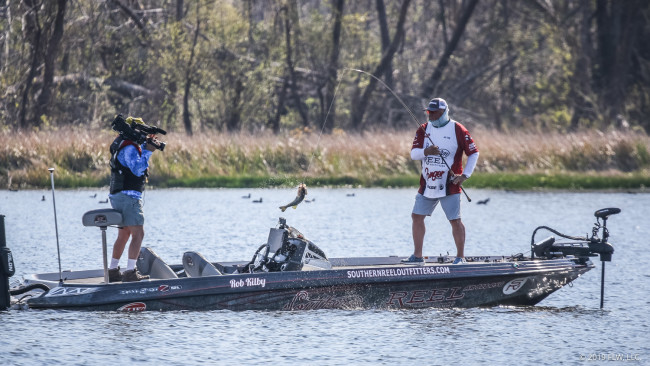
5. Kilby targets prespawners up the Chattahoochee
Rob Kilby of Hot Springs, Ark., probably benefitted from the cold front that pushed through prior to the tournament, helping stall his fish from flooding the bank. He kicked off the tournament 23-3, but by the final day warming temperatures had his fish on the move and he scrapped up 7-5.
Focusing his efforts in a backwater of the Chattahoochee River, Kilby found a stretch of bank with a smattering of good bass cover.
“There’s a lot of hydrilla in Seminole, but not a lot of shallow, good hydrilla,” Kilby says. “The area I found was 3- to 5-feet deep and where the hydrilla survived the hurricane. There was also two or three other grasses mixed together, like reeds and lily pads, and it is always good to have a mix of grass.
“There were also docks behind the grass and a bank with docks will always have more bass on it than a bank without docks. I don’t care where you are.”
A ½-ounce vibrating jig was all Kilby needed to coax prespawn bass into biting.
Kilby shared the area with several competitors over the course of the first few days, but most of them were honed in on the docks and shallow water near the shore. Not Kilby. The hydrilla line that sat just out from the docks was where fish were staging to spawn.
“I actually sat inside the grass, up shallow to make it look like I was fishing the docks and stuff on the bank, but I would cast out towards the hydrilla and that’s where the fish were. Everyone skipped the hydrilla and I had it all to myself.”
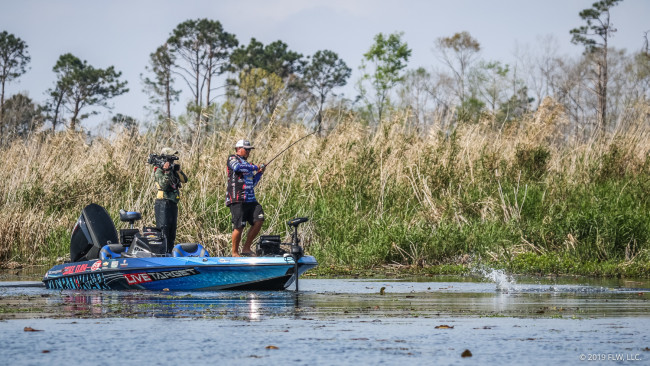
6. Martin chunks and winds, sight-fishes some
Prespawn bass were the primary target of Scott Martin to score his second top 10 in a row.
Martin never had a big day, instead he posted the most consistent weights among the top pros. He weighed 16-7, 16, 14-6 and 15-13 fishing around the Flint River in the stained water working the hydrilla lines along sandbars near channel swings.
“I caught some fish in some of the same places each day, but I also had to fish new water each day as well,” Martin says.
Throughout the tournament fish were pushing shallow and Martin plucked a few off beds each day, mostly in backwaters along the Flint or below the Chattahoochee.
For baits, Martin used a Googan Baits Bandito Bug, a white craw for sight-fishing and a vibrating jig (3/8 or 1/2 ounce, depending on depth) paired with a Googan Baits Krackin’ Craw. Everything was thrown on 15-pound-test P-Line Tactical fluorocarbon, and his rod of choice was either a 7-3, heavy Favorite Rush or a 7-6 Favorite flipping stick.
“All week I could catch one or two here and there, but I never had a place where I could catch them back-to-back like the other guys,” Martin adds.
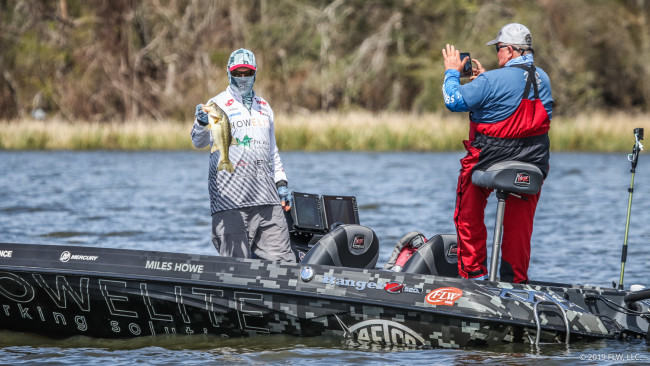
7. Howe slow rolls a ChatterBait
Fishing the same flat as Collings, Miles Howe of San Juan Capistrano, Calif., kept to a 1/2-mile stretch within sight of the dam.
“It was the only place I found with a ton of clean, fresh hydrilla,” Howe says. “I kept my boat in 5 to 7 feet and threw in to 3.”
The only thing Howe needed was a 1/2-ounce Z-Man/Evergreen ChatterBait Jack Hammer with a Pro Point Lures swimbait for a trailer. Howe also opted for a slower retrieve to get bit.
“Everyone around me was fishing fast, but I was barely turning the reel handle – enough to see the rod tip move,” Howe notes. “I actually caught my two better fish by climbing the ChatterBait over the grass instead of snapping it free. I’d just kind of pull up and let it crawl over the grass.”
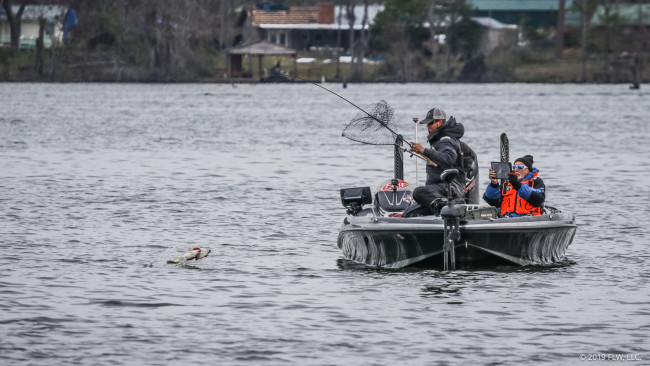
8. Beavers cashes in on morning bite
Tour rookie Bradford Beavers of Summerville, S.C., is no stranger to fishing Lake Seminole, but has never really dialed in the offshore bite – until now.
On day one Beavers loaded with boat with 25-2 in short order. He’d add another 18-12 on day two to take the lead. Unfortunately, he knew his fish wanted to move to the bank and by the weekend his bite would dwindle.
“I was fishing the mouth of Spring Creek on a grass flat where I got two bites in practice and shook them off,” says Beavers. “The first day I threw a Carolina rig on it and had fish grab the bait and spit it. So, I picked up the vibrating jig and it was lights out.”
The bait was a ½-ounce Katch-Her Lures vibrating jig with a swimbait. His bite window lasted about 45 minutes each morning and after that he’d run shallow looking for spawners or fish cruising.
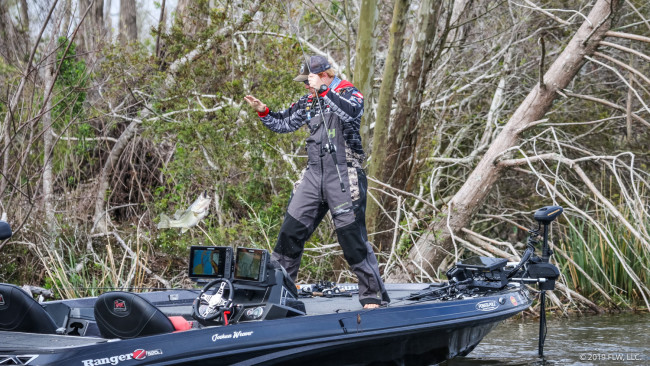
9. Weaver worked current and flipped
The mouth of a backwater in the Chattahoochee River is where Joshua Weaver did the bulk of his work. He also fell in the category of anglers who caught most of their weights right away in the morning.
The Macon, Ga., pro has been fishing Lake Seminole since before he can remember, though most of the experience he has this time of year didn’t factor in during the event.
Like the majority of the top pros, Weaver also used a 1/2-ounce Z-Man/Evergreen ChatterBait Jack Hammer, but paired it with a Zoom Salty Super Fluke for a trailer. He threw it on an Abu Garcia Fantasista Premier rod (7-6, medium heavy) and 20-pound-test Berkley Trilene 100% Fluorocarbon.
“The spot I fished is normally good in the fall,” Weaver says. “I normally catch them in there flipping, but they were grouped up staging there. The problem is that once they leave it and get back in the marsh they can swim anywhere and they get hard to find.
“When you spend three days in a small area you just wear them out and I wasn’t holding anything back each day. By [Sunday] I just ran out of fish and knew my only chance at a big bag was to go sight-fishing. I passed up 10- to 12-pound limits because I wasn’t stopping unless I saw a 5-pounder or bigger. I found four big ones, but they’d swim off the bed and wouldn’t come back.”
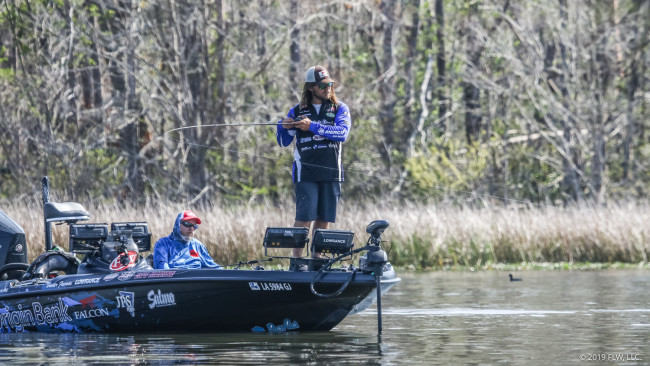
10. Freeman lived in Spring Creek
Hunter Freeman of Monroe, La., posted back-to-back 17-pound limits over the first two days to help push him into his first top 10 in his rookie campaign.
Freeman was targeting prespawn fish farther up Spring Creek than the rest of the top 10.
“There was a 300-yard stretch that had two ditches, a flat and an inside and outside grass line,” Freeman says. “It’s everything you want in a spawning area.”
Dirty water crept its way into his area by the end of the event forcing him to scramble and catch what he could.
The 2018 YETI FLW College Fishing National Champion used two baits. He’d cover water and get a school fired up with a Salmo Squarebill Crankbait in the No. 5 size, but catch his bigger fish on a 1/2-ounce vibrating jig paired with an Xcite Baits Shadnasty.